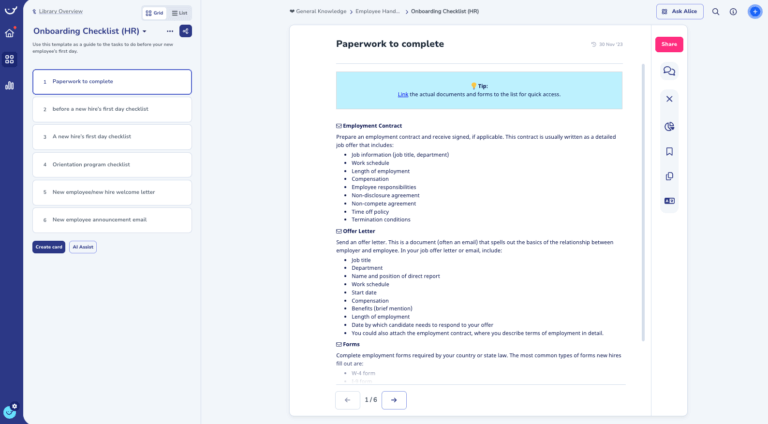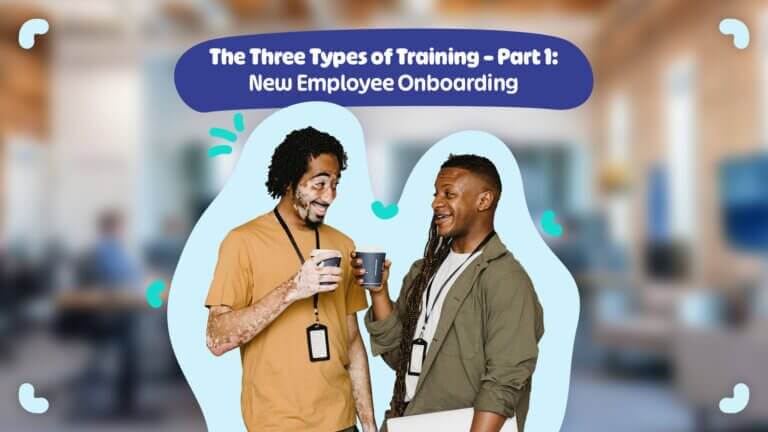Have you ever found yourself reflecting on the early days of your career, back when onboarding meant a whirlwind of paperwork, office tours, and quick introductions?
Those days, while nostalgic, also remind us of how stressful and impersonal the process could be. Fast forward to today, and we’re in a whole new world of digital onboarding.
And trust me, it’s not just about going paperless.
What is digital onboarding?
We we talk about digital onboarding, we don’t mean only remote onboarding. Remote onboarding means onboarding remote employees. You can make use of digital employee onboarding even though your employees are in the office.
In fact, we highly recommend it!
When we say digital onboarding, we talk about onboarding that takes place using digital onboarding tools and processes. Unlike traditional methods, it does not require in-person orientation and manual training.
Realistically, most workplaces, unless fully remote, use a combination of digital onboarding and human interaction, like having a workplace buddy and mentorship.
The Human Side of Digital Onboarding
At Whale, while we’re AI-powered, we believe in the power of human connection, even in a digital space. AI should always be utilized to drive better employee experience and engagement.
Onboarding is about more than just ticking boxes and ensuring compliance; it’s about creating a welcoming environment that fosters growth and relationships from day one.
As someone who values people’s growth and nurtures relationships, you know that the first impression can set the tone for an employee’s entire journey with your company.
Why use digital employee onboarding?
Digital employee onboarding is not just a trend; it’s a necessity in our modern, fast-paced work environment.
One of the primary reasons to adopt digital onboarding is its ability to reach new hires wherever they are. With remote work becoming more prevalent, digital tools ensure that every new employee, regardless of their location, receives a consistent and comprehensive introduction to the company.
But as we mentioned previously, it’s not just about helping remote employees.
Increasing efficiency
Digital onboarding can be more efficient and cost-effective. It reduces the time spent on repetitive tasks and allows HR teams to focus on more strategic initiatives and building relationships, ultimately speeding up the process and reducing costs associated with traditional onboarding methods.
PS. Just having things like your company values and the way you work can help new hires hit the ground running!
We do it ourselves at Whale.
Data-driven improvement
Another compelling reason to use digital onboarding is the wealth of data it provides. Through digital platforms like onboarding software, you can track new hires’ progress, gather real-time feedback, and identify improvement areas.
This data-driven approach allows for continuous improvement, ensuring the onboarding experience improves with each new employee.
A digital approach removes many potential mistakes in onboarding and even potential prejudice.
Compliance
Additionally, digital onboarding platforms often come with built-in compliance features, ensuring that all necessary documentation is completed accurately and on time, reducing the risk of compliance-related issues.
How to implement a digital employee onboarding process?
Implementing digital employee onboarding is no different to any other onboarding process except that the entire process or part thereof takes place utilizing onboarding software.
1. Digital pre-onboarding
Contrary to popular belief, your employees don’t start onboarding once they clock in on their first day. Preboarding is essential!
But doesn’t that mean a mountain of paperwork?
It shouldn’t. What if there was a simple, online way to handle all of that? Enter digital pre-boarding.
Think of digital preonboarding as an online portal where new hires can submit paperwork, complete background checks, and get up to speed on the company. They can even watch a personalized video message from their team leader and connect with future colleagues through online communities.
This way, by the time their first day rolls around, they’re already feeling prepared and excited.
2. Welcoming and Orientation
Making new hires feel comfortable and equipped is crucial.
With a digital platform, new employees can join a virtual welcome session to meet their team and manager. They can also learn about the company culture and values through interactive online modules.
Virtual orientation is a fun and engaging alternative to long in-person sessions, helping new hires start strong in their new roles.
3. Training and Development
Companies with robust training programs see a 218% higher income per employee compared to those without.
Digital onboarding training swaps traditional learning for an online library packed with short, interactive courses tailored to each employee’s role and the company’s processes.
These courses are engaging and easy to follow, thanks to videos and fun activities. Plus, managers can create personalized training plans and provide real-time feedback and mentorship, helping new employees develop new skills without feeling overwhelmed.
4. Ongoing Support and Feedback
Learning doesn’t stop after initial training – in fact true onboarding lasts 90 days and even up to a year!
Digital onboarding offers a continuous feedback loop. New hires can access knowledge bases and FAQs for ongoing reference, and regular check-ins with managers for feedback, performance discussions, and development opportunities.
This continuous support helps new hires thrive, creating a healthy environment for ongoing learning and growth.
Challenges of digital employee onboarding - How to bridge the gap?
I know what you might be thinking – can digital onboarding really replace the face-to-face interactions we’re so accustomed to? The truth is, it doesn’t have to be one or the other. A blended approach can bridge the gap beautifully.
It’s important to keep in mind the 5C’s of onboarding namely, compliance, clarification, confidence, connection, and culture.
Digital employee onboarding doesn’t mean that onboarding should be disengaging.
Got questions on your mind?
Book a demo with our team today!
How to create a positive onboarding experience?
Digital onboarding offers a unique opportunity to make that first impression a memorable one.
Here’s how you can make it work:
- Personalized Welcome: Imagine starting your first day with a personalized video from your manager or a future colleague. It’s a small gesture that can make a huge difference in making someone feel valued and connected immediately.
- Interactive Training Modules: Ditch the boring slide decks. Use interactive modules that engage new hires with quizzes, scenarios, and even gamified learning. It’s not just about transferring knowledge but also about engaging their curiosity and excitement.
- Virtual Coffee Chats: Setting up informal virtual meet-and-greets can help new employees get to know their teammates without the pressure of formal introductions. Encourage them to share a bit about themselves, their hobbies, or even their favorite books. These casual chats can be the starting point of lasting professional relationships.
- Hybrid Meetings: Schedule some onboarding activities in person, if possible, to balance the digital interactions. This hybrid approach ensures that new hires still get a taste of the office culture.
- Mentorship Programs: Pair new employees with mentors who can guide them through their initial weeks. This one-on-one interaction is invaluable, whether it happens in person or via video calls.
Leveraging technology for onboarding
Leveraging technology doesn’t mean losing the personal touch. It’s about using tools to enhance the experience. Here are a few tips:
- Onboarding Tools: Create a central hub or knowledge base where new hires can find all the resources they need – from company policies to fun facts about their team.
- Feedback Mechanisms: Set up regular check-ins and feedback loops to understand how new hires are settling in and what can be improved. This shows that you care about their experience and are committed to their growth.
- Automate where possible: Automating certain onboarding tasks frees everyone up to enjoy the process of a new workplace and new team member.
How to Improve the Digital Employee Onboarding Experience?
Improving the digital onboarding experience is an ongoing process but here are a few best practices;
- Ensure your onboarding content is engaging and relevant. Use a mix of videos, interactive tutorials, and real-world scenarios to keep new hires engaged.
- Make use of an employee onboarding checklist to see that nothing falls through the cracks.
- Regularly update this content to reflect any changes within the company or industry. Providing a clear and structured onboarding roadmap helps new employees know what to expect and when, reducing anxiety and confusion during their first few weeks.
- Gather feedback. Encourage new hires to share their thoughts on the onboarding process through surveys or informal check-ins. This feedback is invaluable for identifying areas of improvement.
- Utilize a digital onboarding platform that is user-friendly and accessible. Technical difficulties can be a major frustration for new employees, so investing in a reliable, easy-to-navigate platform is crucial.
Finally, don’t forget the human element. Even in a digital space, regular personal interactions and check-ins can make new hires feel valued and supported.
A personal example

Bottom line?
The next time you welcome a new team member, think about how you can make their digital onboarding experience not just efficient but also heartfelt and memorable. After all, these moments of connection turn colleagues into friends and a job into a journey.
Let’s make onboarding not just a process but a warm welcome to the family.
To help you, here’s a selection of onboarding templates you may want to use.
FAQs on Digital employee onboarding
What types of software do I need for digital employee onboarding?
There are a few types of software you might consider using;
- Employee onboarding software
- An HR automation tool
- Intranet
- Employee training software









